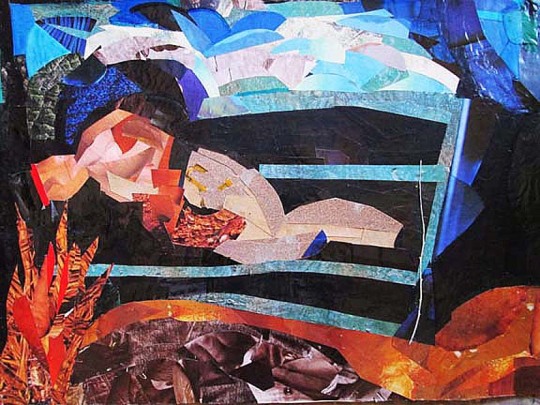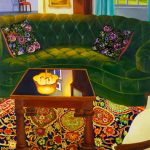Business of Art | Protect Your Work from Natural Disasters
A disaster plan is essential for a safe and sustainable creative practice.
At New York Foundation for the Arts (NYFA), we strive to empower artists to apply business principles to their creative careers with the goal of supporting their work and growing resources for their projects over the long haul. As winter weather impacts several areas in the country, and natural disasters, including tornadoes, hurricanes, and earthquakes, remain a threat for many communities, businesses are updating their disaster plans, and we believe strongly that artists should, too. A disaster plan is essential for any artist looking to build and maintain a safe and sustainable creative practice.
This post is part of an ongoing series on how artists can both prepare for and recover from emergencies of all kinds. We recently wrote about how to protect your work from flooding. While the focus of this post is natural disasters, we’ll introduce general principles that can be applied to other types of emergencies. Please check our blog for future posts and visit the many resources included at the bottom of this article.
Best practices for creating an artist-centered disaster plan include the following: (1) know your risks, (2) document your work and safeguard your records, and (3) get appropriately insured.
Know Your Risks
Learn the weather-related risks to the geographic region in which you live and/or work, have an evacuation plan and/or safe space for yourself and others, and sign up to receive emergency alerts and notifications with your township or county. FEMA has an interactive map to identify flood zones, this resource from the EPA shows historical hurricane tracks and strike frequency, and you can also contact your local authorities to understand potential hazards and resources that are in place.
Once you are aware of the weather-related risks to the region, check your building, your materials, and storage spaces for possible problem areas. The CERF+ Studio Safety Guide is an excellent resource to understand the risks associated with your surroundings, and can be adapted for non-visual artists. If you work in an area that is prone to snowstorms or extreme cold, make sure your space is properly insulated and learn how to keep pipes from freezing. For artists working in areas with a moderate-to-high risk of earthquakes, store your work, along with heavy or breakable items, on low shelves and use anchors to secure bookcases and other storage to the walls. If you are worried about hurricane damage, install permanent storm shutters if possible, and declutter drains and gutters.
Document Your Work and Safeguard Your Records
Depending on the potential risks associated with your workspace and/or geographic location, you’ll want to store your most important records and/or work appropriately: not in a basement or directly on the floor, in waterproof containers when possible and away from light, and maintain a digital documentation of them. Visual artists should get in the habit of taking photographs of completed work. Performance artists and/or writers should maintain electronic copies of work, not just on a hard drive, but also in a removable flash or external hard drive in a fireproof and waterproof box. We also suggest potentially using a cloud-based service like Google Drive for extra security. Make regular back-ups.
As part of your digital inventory of work, all artists should scan and save important documents directly related to your creative practice, such as original drafts of writing with marginalia or promotional materials for shows, as well as documents related to the business side of your practice, including receipts, grant award letters, and/or other tax and legal information. An inventory is important both for your artistic legacy as well as it is often necessary when applying for post-disaster emergency funding or when submitting an insurance claim.
If you don’t have a scanner, you can download a free scanner app on your phone, such as Adobe Scan, which enables you to take photos and turn them into PDFs. Dance/USA and CERF+ both offer template artist inventories that you can download for free.
Get Appropriately Insured
Most homeowners or renters insurance does not cover losses related to your creative practice even if you work from home because these items are considered “business property.” You’ll need either an in-home business owner’s policy, a business rider to your existing insurance plan, or a separate business insurance policy. Your creative career is a business and while you’ll want to avoid unnecessary coverage, you do want to protect it and not take the risk of being uninsured.
Talk to your insurance agent and make sure that your insurance covers risks associated with your geographic location. Losses due to floods and earthquakes, for example, are not included in standard homeowners, renters, or business insurance and require additional policies. Be wary of exclusions, and don’t be shy about asking your insurance agent about them.
Additional Resources
There are several ways to approach disaster planning: you could set aside a full day over the weekend to review risks to your workspace, repair problem areas, document your work, and get insurance. Alternatively, you could check off one step at a time over several weeks. Below are additional resources to aid you in your planning. As a general rule, disaster planning usually requires an initial time commitment when starting from scratch, but once you have the structures in place and abide by them, you can focus on making art and building your creative career.
- Ready.gov Disaster Plan site with disaster-specific information for before, during, and after an emergency
- FEMA Safeguard Critical Documents and Valuables checklist
- CERF+ Studio Protector portal and Insurance Hub
- Dance/USA Artist’s Legacy Toolkit
- Joan Mitchell Foundation’s Archive Planning Workbook for Visual Artists
- NYFA.org Emergency Resources section
- American Institute for Conservation of Historic and Artistic Works: Wiki for Preservation of Time-Based and Electronic Media
- Preparedness resources for a variety of emergencies compiled by the National Coalition for Arts’ Preparedness & Emergency Response (NCAPER)
– Maria Villafranca, NYFA Consultant and NYFA Coach
Image: Teressa Valla; Embrace the Reality; 2012; collage, twig sandpaper, and watercolor
Visit NYFA’s full list of emergency resources and visit NYFA Source, a free directory of over 12,000 opportunities, grants, and services for individual artists nationwide. This post is the second in a series of articles, Protect Your Work, and will be supplemented with a How to Recover from an Emergency series.
You can find more articles on preparedness and other arts career topics by visiting the Business of Art section of NYFA’s website. Sign up for NYFA News and receive artist resources and upcoming events straight to your inbox.





